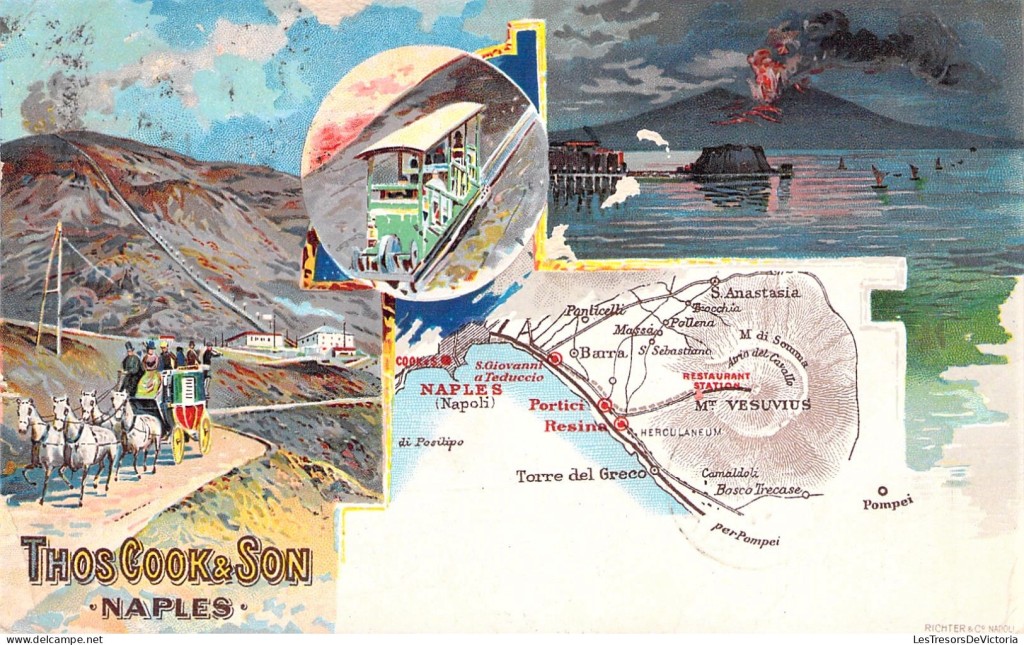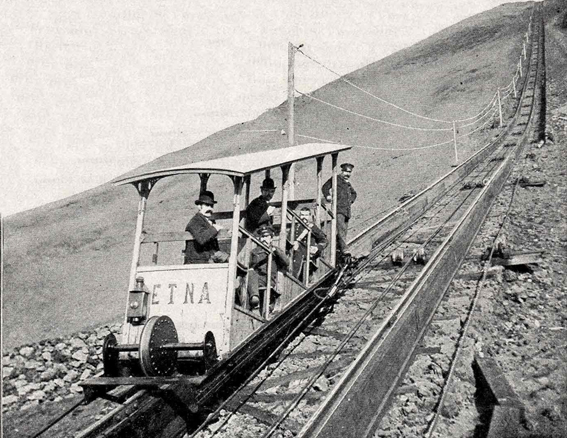
Grove Koger
After writing my March 17 post about Vesuvius, I discovered that it was once possible to reach the summit of the famous volcano by funicular. Then my good friend Amy Vecchione mentioned that older members of her family, the Marottas and the Vecchiones, actually remembered using the funiculars. However, their ascents apparently aggravated their acrophobia, a condition I’m intimately familiar with.
In the early 1870s, Italian painter Giuseppe de Nittis required “six hours on horseback” to accomplish the ascent, and had “to make the final climb to the crater on the shoulders” of his guides. But by then, Hungarian engineer Ernesto Emanuele Oblieght had already commissioned a trio of engineers to draft a plan for the construction of a funicular railway up the steepest slope of the volcano. However, the task took years to accomplish, and it was only on June 10, 1880, that the system was opened to the public. (That’s it you see in the photograph below by Giacomo Brogi.)

Here I should explain that a funicular is a particular kind of cable-operated railway system designed to run on steep slopes. It consists of a pair of carriages connected to the opposite ends of a single cable and running on parallel tracks. This arrangement allows for one carriage to ascend as the other descends, significantly reducing the amount of force necessary to move them. In the case of some funiculars, there are two sets of tracks running beside each other, while in other, narrower designs, there is a single set that splits into two for a short distance at the midpoint, allowing the two carriages to pass each other. Boarding stations are built at each end of the rails. Maggie and I have ridden on several funiculars in Europe, and the experience is always a fascinating one.
Interestingly enough, my 1900 edition of Baedeker’s Southern Italy refers to the system on Vesuvius as a “Wire-Rope Railway,” and adds that the trip then took 12 minutes. “At the uppper station … travellers are conducted by a tolearable footpath over ashes and slag to the … summit of the crater, which presents an imposing picture.”
The funicular was sold in 1886 to the Société Anonyme du Chemin de Fer Funiculaire du Vèsuve, but, after a short time, the company went bankrupt and was purchased by the famous firm of Thomas Cook and Son (who were responsible for printing the lithograph at the top of today’s post). In time, the funicular was replaced (or perhaps supplemented) by a rack-and-pinion railway, in which a cog wheel beneath the carriage engaged a toothed rail between the tracks. However, volcanic eruptions in 1906, 1911, and 1929 damaged the system, and a severe 1944 eruption destroyed it completely.

There’s quite a bit more to the saga, including the establishment of a hotel, visible as a tiny dot on the two-panel postcard above (reproduced courtesy of Stamp Community Family) halfway up the slope. But I’ll leave it to you to read as much as you care to by going to the generously illustrated sites PompeiiinPictures and Tramway Information. Or you can watch this YouTube video assembled by Ruairidh MacVeigh and based on the Thomas Cook Archive and Wikipedia.
Should you be contemplating a visit in the near future, you can now take a short train ride from Naples on the EAV (Ente Autonomo Volturno) Circumvesuviana to Ercolano, then follow it up on a shuttle bus. Nessun problemo. I also understand that, thanks to a system of well-maintained trails, hiking up the side of Vesuvius is easy now, and that you can even buy snacks and drinks along the way. But keep in mind that it is a volcano …
Two notes: The Vesuvius funicular is said to have inspired the 1880 song “Funiculì, Funiculà,” by Peppino Turco and Luigi Denza. And … the name “Etna” that you see on the carriage in the image below (reproduced courtesy of VolcanoCafé) may have been intended as a joke, as the volcano Etna is actually on the Italian island of Sicily, some 214 miles, or 345 kilometers, from Vesuvius.

If you’d like to subscribe to World Enough, enter your email address below:
And if you’ve enjoyed today’s post, please share!